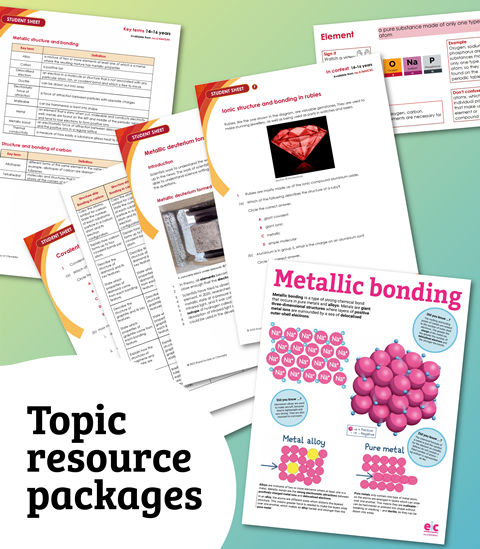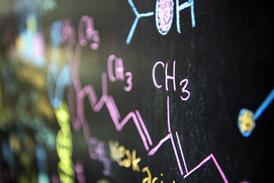All RSC Education articles in Non-EiC content – Page 3
-
 Resource
ResourceAtoms and ions | Developing understanding | 14–16 years
Encourage learners to think about how atoms and ions are represented and what this means at the sub-microscopic level
-
 Resource
ResourceAtoms and ions of copper | Johnstone’s triangle worksheets | 14–16 years
Use these worksheets to develop learners’ understanding of atoms and ions, including a demonstration of a metal displacement reaction
-
 Resource
ResourceDecision tree: acid, base or buffer? | 16–18 years
Help learners understand which equation they need to answer questions about acids, bases and buffers by scaffolding their thinking
-
 Resource
ResourceAtomic structure of lithium | Johnstone’s triangle worksheets | 14–16 years
Use these worksheets to develop learners’ understanding of atomic structure, using the example of lithium
-
 Lesson plan
Lesson planWriting formulas for ionic compounds | 14–16 years
Practise writing formulas for ionic compounds and revise common positive and negative ions, using this lesson plan with activities
-
 Resource
ResourceAtomic structure | Developing understanding | 14–16 years
Encourage learners to think about how the atomic structure is represented and what this means at the sub-microscopic level
-
 Resource
ResourceParticle diagrams and coffee shops | In context | 14–16
Put particle diagrams into context and practise maths in science with a visit to a coffee shop
-
 Resource
ResourceParticle diagrams | Knowledge check | 14–16
Assess learning on particle diagrams with worksheets at foundation and higher level
-
 Resource
ResourceThe structure of benzene | 16–18 years
Use this worksheet with classroom slides and card sort activity to explore the structure of benzene with your learners
-
 Lesson plan
Lesson planMetallic bonding and the structure of iron | Lesson plan | 14–16 years
Explore how the bonding in iron relates to its physical properties and address common misconceptions using this lesson plan with activities
-

-
 Resource
ResourceMetallic bonding in electric cars | In context | 14–16
Put metallic structure and bonding into context and practise maths in science with questions about electric cars
-
 Resource
ResourceMetallic bonding | Knowledge check | 14–16
Assess learning on metallic bonding with worksheets at foundation and higher level
-
 Resource
ResourceIonic structure and bonding | Knowledge check | 14–16 years
Assess learning on ionic structure and bonding with higher and foundation worksheets
-
 Resource
ResourceIonic structure and bonding in rubies | In context | 14–16 years
Put ionic bonding into context with questions about rubies, their composition and dazzling properties
-
 Lesson plan
Lesson planBonding bingo: bonds and properties of substances | 14–16 years
Try this game and lesson plan to reinforce learners’ understanding of bonding and how it relates to the physical properties of substances
-
 RSC News
RSC NewsEffective pedagogy: a new self-led teacher professional development course
Delve into the principles and practices of effective chemistry teaching
-
 Resource
ResourceStructure and bonding | Key terms support | 14–16
Language support pack for structure and bonding, with key terms list, accessible glossary, Frayer models and unscrambling definitions
-
 Resource
ResourceParticle model | Key terms support | 11–14
Language support pack for particle model, with key terms list, accessible glossary, Frayer models and unscrambling definitions
-
 Resource
ResourceAtomic model | Key terms support | 14–16
Language support pack for atomic model, with key terms list, accessible glossary, Frayer models and unscrambling definitions











